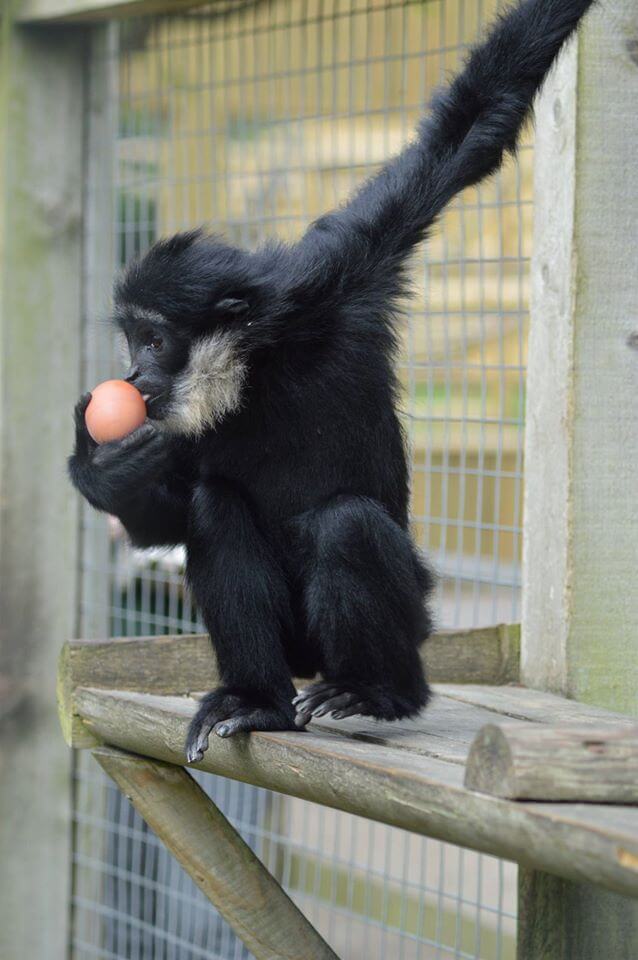Pickle, the gibbon, is one of the biggest characters at the park and is one of the animals which our regular visitors will look out for and ask the keepers how she is and what she’s been up to. Recently Pickle has moved enclosures to be right next to her family to allow us to start the process of introduction to her father, Laos…
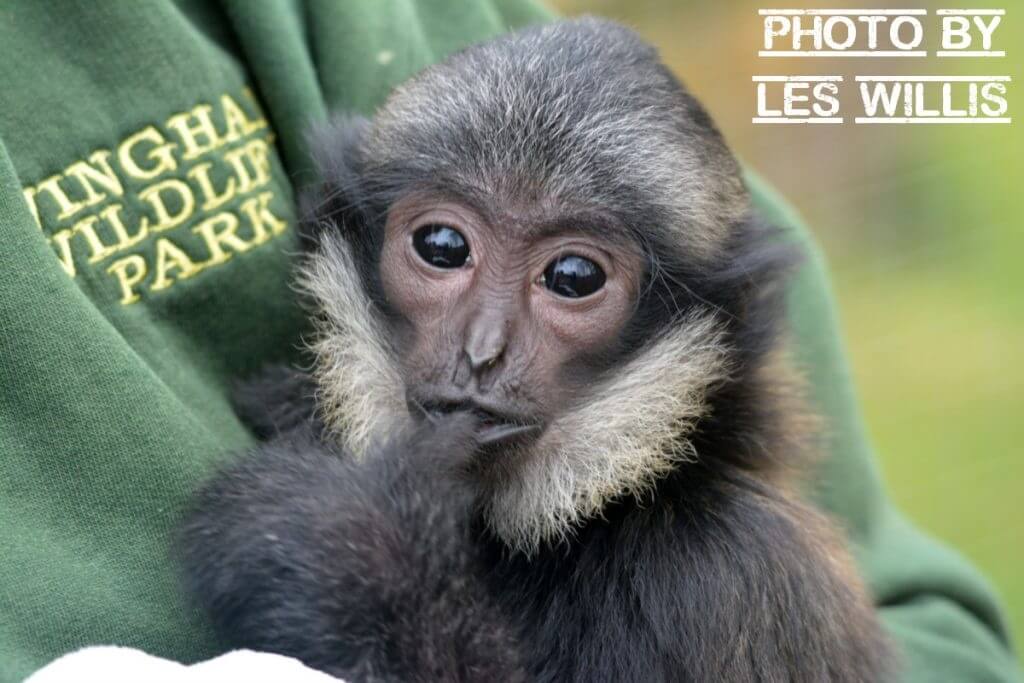
But why is Pickle not with her parents?
Pickle unfortunately was rejected at birth by her mother Vera. She was found whilst Becky (one of our keepers) was doing her morning rounds on 18th September 2012, on the floor of the gibbon house, cold and barely clinging to life. I will never forget the radio call of “Vera’s had a baby and it’s on the floor”. We all rushed to the enclosure where Tony the owner of the park made the decision immediately that we needed to intervene. Pickle was scooped up and held under Tony’s top to start the process of warming her up. Once she was in our medical room we could then begin the slow process of warming her through with heat pads. This took about 4 hours before we were able to give her her first feed of milk. This then began the long journey that we would go through together over the coming months and years.
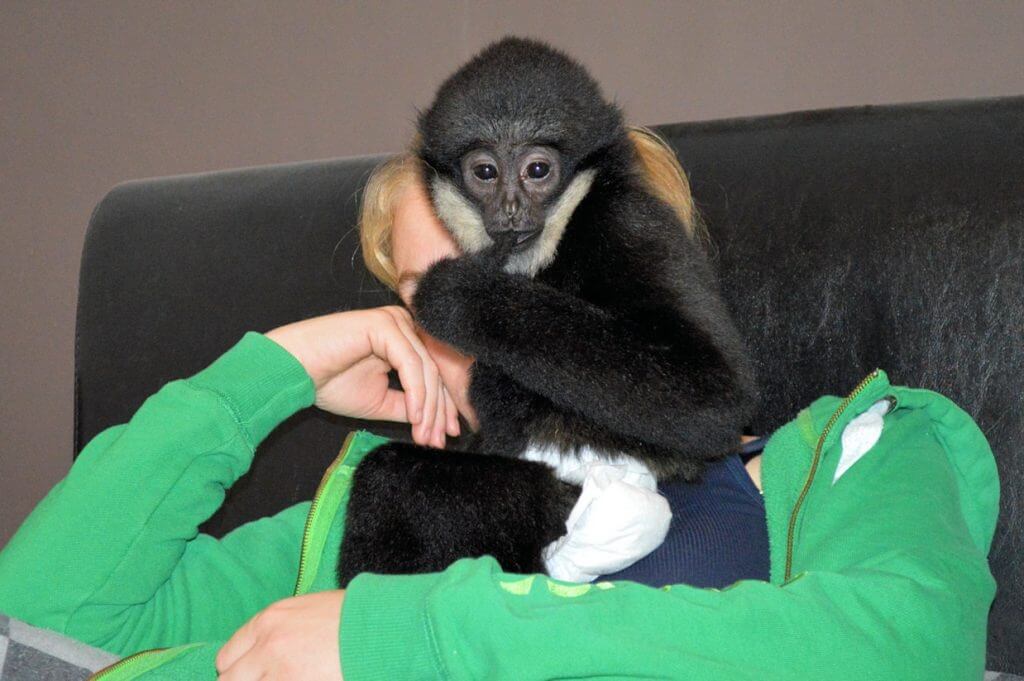
Hand rearing at WWP
Where ever possible it is important for animals to be reared by their parents, however there are situations where this is not the best outcome for an individual, and needs to be evaluated on an individual basis. For us it is important that every baby born at the park is given the best opportunity to grow up happy and healthy. Variables such as an inexperienced mother, a mothers inability to produce milk or aggressive siblings may mean that it is simply not safe for an animal to be reared by its parents.
I had hand reared baby lemurs from birth before but never a gibbon. I was quite nervous as baby gibbons stay with their mothers for a lot longer period than lemurs. The weaning period for lemurs is about 5 months but gibbons is 18 months. It was going to be mine and the other keeper’s task to look after her day and night for potentially the next 18 months, unless we could re-introduce her to her mother.
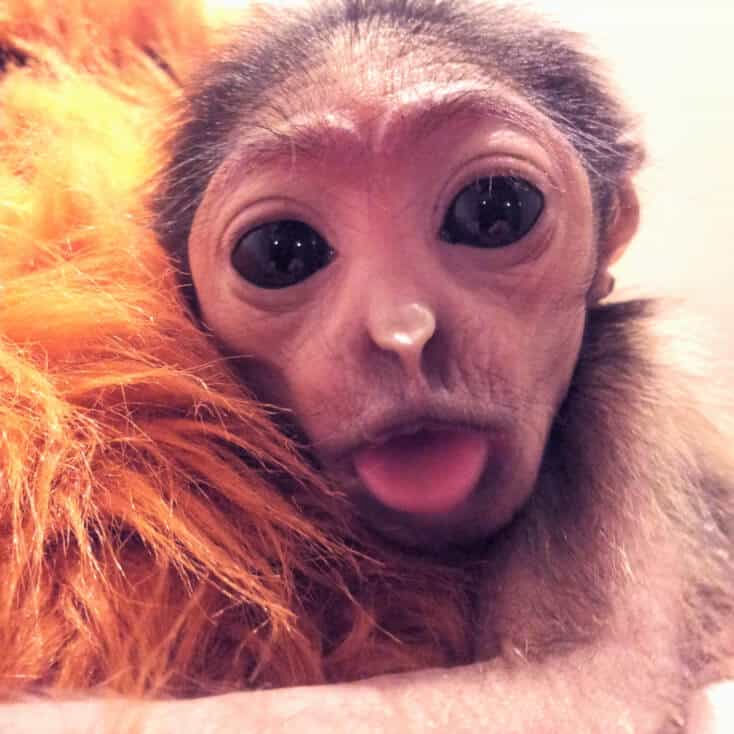
Pickle was fed every 2 hours around the clock for the first two weeks. This time then increased between feeds with more milk being given at each stage. She had a teddy which was her surrogate mum when I was at work, which she clung on to with that amazing grip that baby primates have. She was a fairly easy baby to feed and was fed with a normal human baby’s bottle…
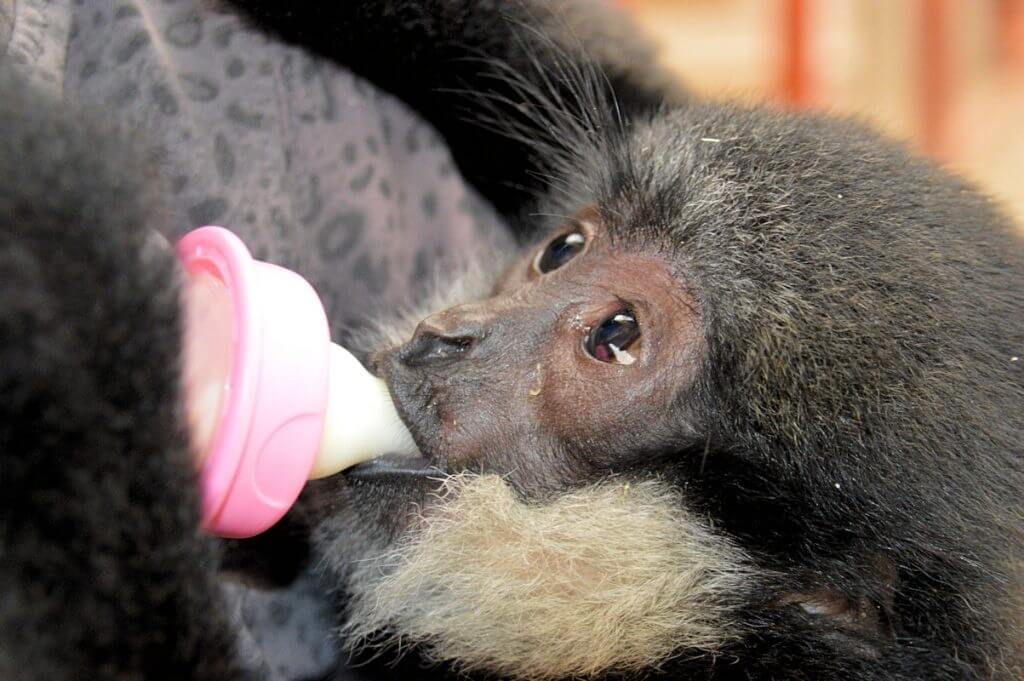
DIY nappies
…The other end however was not so easy. She made a lot of mess and so it was decided that creating nappies was the only way forward. As gibbons do not have tails making a nappy was quite straight forward as there was no need for a tail hole. I cut up some blanket into triangle shapes and then used a cut down sanitary towel as the absorbent inside. As she grew we were able to then change to micro nappies that are designed for premature babies. Her first month was spent inside a brooder which controls the temperature and humidity. After this period she moved to a small cage with a few ropes in to try and encourage her to start to climb a little. We started to also introduce her to solid food at this stage, offering soft fruits and cooked vegetables.
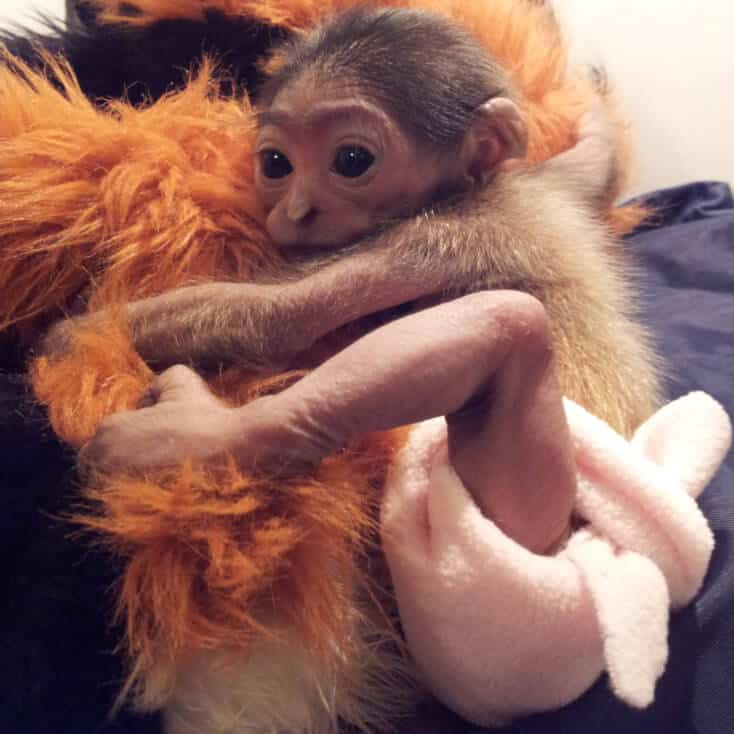
Getting to know her mother
At an early stage we started to take Pickle down to her mother to let Vera see her and smell her. Pickle showed a small amount of interest and would look about at the gibbons swinging around. Vera however was not happy. She would start to display and be extremely aggressive towards Pickle whenever we would take her to the enclosure. She would see me coming from a distance carrying Pickle in her blanket and immediately start displaying. Things were not going well with Vera but we kept trying and hoped that at some point Vera may calm down and show some interest in her daughter. Sadly however this has never happened and we firmly believe that from Vera’s reaction if we were to just leave Pickle in the enclosure Vera would most likely harm or even kill her.
Back to the drawing board
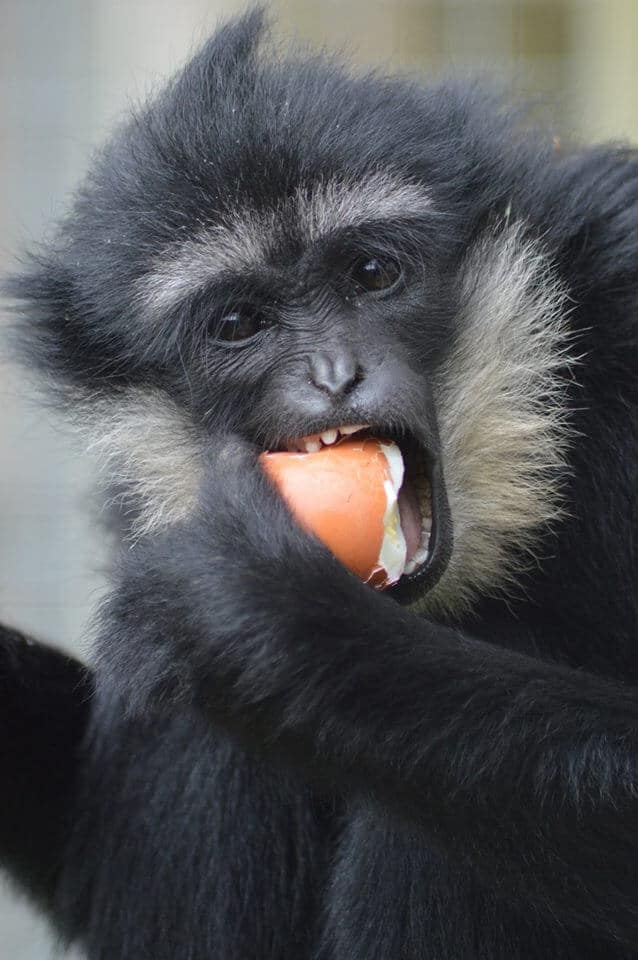 As Pickle grew she moved home to bigger and bigger enclosures with the other primate keepers starting to take their turn at bottle feeding her. At a year old she was only having 3 – 4 bottles of milk a day and was eating a lot more solid food. Mango, peppers and sweet potato are still her favourites, but we always make sure to try different foods with young animals just as you would with human babies.
As Pickle grew she moved home to bigger and bigger enclosures with the other primate keepers starting to take their turn at bottle feeding her. At a year old she was only having 3 – 4 bottles of milk a day and was eating a lot more solid food. Mango, peppers and sweet potato are still her favourites, but we always make sure to try different foods with young animals just as you would with human babies.
Our next plan was to introduce Pickle to her father Laos. We waited until Pickle was old enough to be spayed because Laos probably wouldn’t recognise her as his own and would likely see her as just another female gibbon. Pickle was spayed at around one year old and once she had healed the introduction process began with Laos. We would shut Pickle in one side of the gibbon house then allow Laos into the other side. First there was aggression from both sides but gradually they calmed down and Pickle started to show interest and Laos did the same. After a number of weeks doing this we decided to take Pickle into the outside enclosure whilst Laos was inside to allow her to get used to the ropes and climbing around by herself.
The next step was the biggest. Letting Laos outside with Pickle. For this part I was extremely nervous and it wasn’t a good idea for me to be around as Pickle may sense my worry and I could make the situation worse. Therefore it was down to the other keepers to step in. The first few introductions went ok, but not great as Pickle just stayed on the floor and didn’t know what to do. She didn’t know how to be a gibbon. That was something I couldn’t teach her and she was going to have to pick up cues from the other gibbons by herself. As we progressed with introduction everything seemed to be better and we even got to the stage of leaving Pickle alone with Laos with us checking back every few minutes. However late in the day of the second week of introductions as I was collecting Pickle to take her back to her own enclosure I noticed something wasn’t right. She was very quiet and clinging and Laos had been in the house for a while not coming out. Once I got her back to her own enclosure I gave her a good check over and discovered a deep bite to her backside. After a trip to the vets for a clean and stitches the decision was taken to suspend introductions until Pickle was bigger and better at understanding gibbon language and behaviour.
Learning to be a gibbon
During the next 18 months Pickle grew into a playful, cheeky gibbon (who even enjoyed feeding Baxter, the family dog) who sings when I sing to her (gibbon language of course) and will come over to see and play with her keepers. She is very strong and she does bite even if it is playing it still hurts. Many visitors will say to me “wow wish I could have one”. My response to this is “you really wouldn’t”. Gibbons are meant to be with their own kind and it is my mission to make sure that this happens. Being so close to the other gibbons has allowed Pickle to watch and observe them. She is much more gibbon now and the keepers have reduced our contact time with her.
Pickle has now moved right next door to her father Laos as Vera still doesn’t want to know her. Our plan is to introduce Pickle to Laos once again. Having Pickle right next to him has allowed her to watch him constantly and gain confidence in becoming a gibbon. We have only seen Pickle go to the floor on a few occasions since moving her to her new enclosure which is much more like being a gibbon as they rarely in the wild would go to the forest floor.
Here’s to the future
Introductions between animals can always be a difficult and challenging time for both their keepers and the animals themselves. Knowing when to intervene if things aren’t going as planned and when to leave them to sort out on their own is a fine line. Patience and time are all that we can give them to get to know each other and to hopefully get along.
We hope that soon we will be able to open up the door between the two enclosures and allow Pickle and Laos to be together as they both will hopefully enjoy each other’s company and become friends.
So that’s the story of how Pickle went from this:
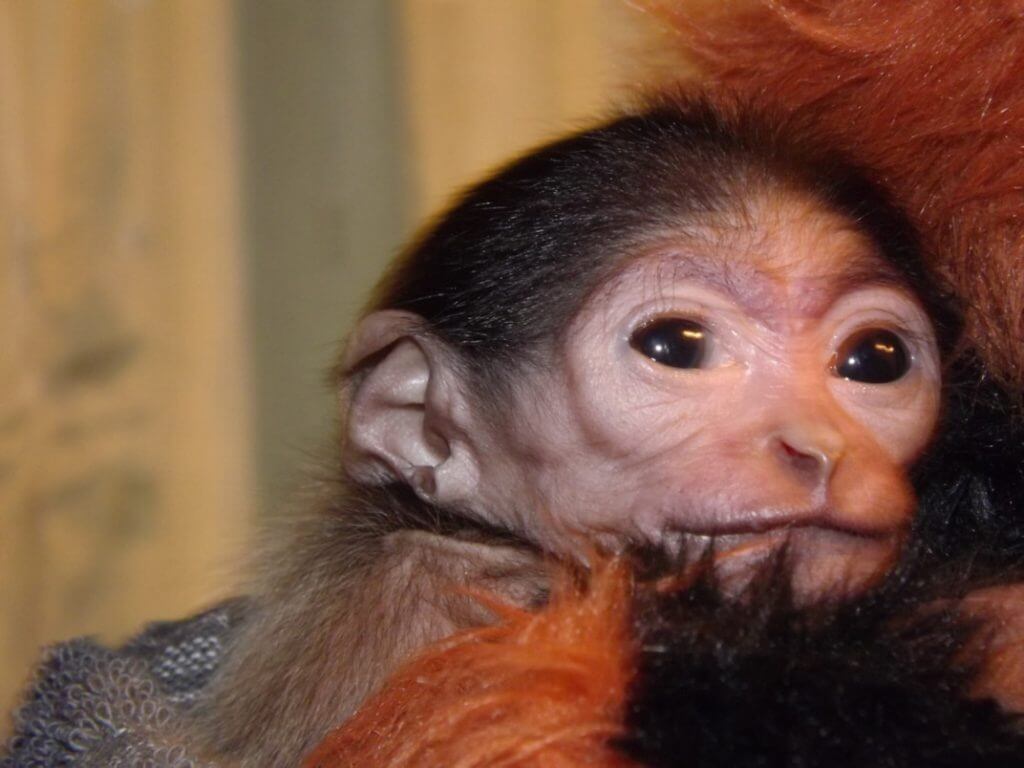
…A delicate little baby to this:
…A playful, energetic and absolutely lovable bundle of fun!
